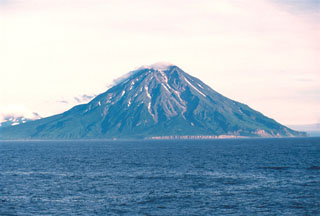Report on Fuss Peak (Russia) — October 1982
Scientific Event Alert Network Bulletin, vol. 7, no. 10 (October 1982)
Managing Editor: Lindsay McClelland.
Fuss Peak (Russia) Increased thermal activity
Please cite this report as:
Global Volcanism Program, 1982. Report on Fuss Peak (Russia) (McClelland, L., ed.). Scientific Event Alert Network Bulletin, 7:10. Smithsonian Institution. https://doi.org/10.5479/si.GVP.SEAN198210-290340
Fuss Peak
Russia
50.267°N, 155.246°E; summit elev. 1742 m
All times are local (unless otherwise noted)
Recent aerial infrared surveys and ground investigations have shown increasing thermal activity at Fuss Peak. Gorshkov (1967) reported that there was no fumarolic activity at the volcano, E. K. Markhinin found only very minor signs of it in 1969, and fumaroles were not observed during 1971-1976 overflights. In 1973, an aerial infrared survey detected weak thermal anomalies over an area of about 104 m2 in the N and E parts of the crater and on its E rim (Gusev and Zelenov, 1979). When the volcano was resurveyed in 1978, intense thermal anomalies were measured over most of the 700-m-diameter crater, extending down to its bottom about 200 m below the rim. Weak fumaroles were observed in the E and central part of the crater. The 1978 resurvey also found a 50-80 m-wide zone of anomalously high temperatures extending 250-300 m down the E flank from the crater rim (Gusev and Zelenov, 1979). Fumaroles were seen on the E flank during an overflight in the fall of 1981.
G. S. Steinberg visited the volcano in September 1982 and found fumaroles at the base of both the W and E sides of the crater's small median ridge. Activity was stronger at the E base of the ridge, where there were two groups of fumaroles, each with three powerful vapor jets with temperatures of 95-96°C. Bright yellow sulfur crystals were present in some of the vents. Despite the fumaroles, the majority of the crater floor was snow-covered. Many weak fumaroles were observed in a zone of small fissures on the upper flank in the immediate vicinity of the crater rim, but none had deposited sulfur. About halfway down the cone, in a narrow, shallow canyon that was apparently an extension of the upper flank fissure zone, there were three groups of fumaroles, separated by 30-60 m, vigorously emitting a mixture of steam and other gases. Temperatures at these vents were 94-96°C and they had deposited bright yellow sulfur. Within the fissure zone, temperatures at 30-40 cm depth were 9-13°C. Temperatures at similar depths outside the zone were 3-4°C.
References. Gorshkov, G.S., 1967, Vulkanizm Kurilskoi Ostrovnoi Dugi: Nauka, Moscow, 288 p.
Gusev, N.A., and Zelenov, E.N., 1979, The activization of heat regime of the Fuss Peak volcano according to the heat aerial surveying: Volcanology and Seismology, no. 4, p. 102.
Geological Summary. Fuss Peak in the northern Kuriles forms a peninsula that lies across a low isthmus on the SW coast of Paramushir Island. The volcano rises 2800 m from the floor of the Sea of Okhotsk to a height of 1742 m. This isolated symmetrical andesitic stratovolcano has a 700-m-wide, steep-walled crater that is 300 m deep. A deep notch cuts the NW rim of the crater to the level of the crater floor, at the head of a canyon that reaches the coast. Well-preserved lava flows occupy the middle and lower flanks, particularly on the E and SE sides. Only one unambiguous historical eruption, in 1854, is known. Reports of eruptions in 1737, 1793, 1857, and 1859 are false (Gorshkov, 1970). Murayama (1987) also listed an eruption in 1742 (only earthquakes and a tsunami are cited by Sapper, 1917) and "smoke" emission in 1933.
Information Contacts: G. Steinberg, Sakhalin Complex Institute.

